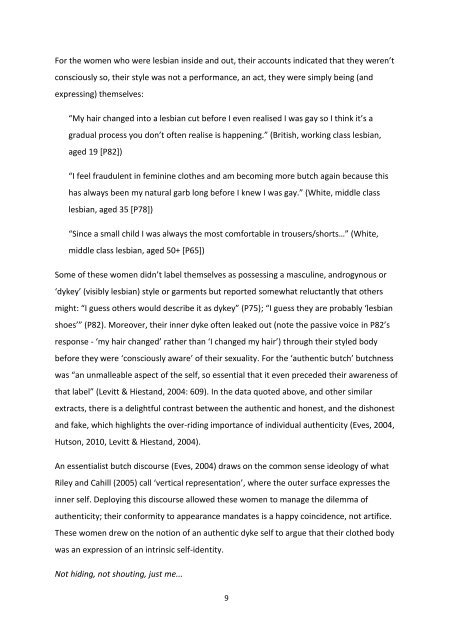Clarke, V. and Spence, K. (2012) I am who I am? Navigating norms ...
Clarke, V. and Spence, K. (2012) I am who I am? Navigating norms ...
Clarke, V. and Spence, K. (2012) I am who I am? Navigating norms ...
Create successful ePaper yourself
Turn your PDF publications into a flip-book with our unique Google optimized e-Paper software.
For the women <strong>who</strong> were lesbian inside <strong>and</strong> out, their accounts indicated that they weren’t<br />
consciously so, their style was not a performance, an act, they were simply being (<strong>and</strong><br />
expressing) themselves:<br />
“My hair changed into a lesbian cut before I even realised I was gay so I think it’s a<br />
gradual process you don’t often realise is happening.” (British, working class lesbian,<br />
aged 19 [P82])<br />
“I feel fraudulent in feminine clothes <strong>and</strong> <strong>am</strong> becoming more butch again because this<br />
has always been my natural garb long before I knew I was gay.” (White, middle class<br />
lesbian, aged 35 [P78])<br />
“Since a small child I was always the most comfortable in trousers/shorts…” (White,<br />
middle class lesbian, aged 50+ [P65])<br />
Some of these women didn’t label themselves as possessing a masculine, <strong>and</strong>rogynous or<br />
‘dykey’ (visibly lesbian) style or garments but reported somewhat reluctantly that others<br />
might: “I guess others would describe it as dykey” (P75); “I guess they are probably ‘lesbian<br />
shoes’” (P82). Moreover, their inner dyke often leaked out (note the passive voice in P82’s<br />
response - ‘my hair changed’ rather than ‘I changed my hair’) through their styled body<br />
before they were ‘consciously aware’ of their sexuality. For the ‘authentic butch’ butchness<br />
was “an unmalleable aspect of the self, so essential that it even preceded their awareness of<br />
that label” (Levitt & Hiest<strong>and</strong>, 2004: 609). In the data quoted above, <strong>and</strong> other similar<br />
extracts, there is a delightful contrast between the authentic <strong>and</strong> honest, <strong>and</strong> the dishonest<br />
<strong>and</strong> fake, which highlights the over-riding importance of individual authenticity (Eves, 2004,<br />
Hutson, 2010, Levitt & Hiest<strong>and</strong>, 2004).<br />
An essentialist butch discourse (Eves, 2004) draws on the common sense ideology of what<br />
Riley <strong>and</strong> Cahill (2005) call ‘vertical representation’, where the outer surface expresses the<br />
inner self. Deploying this discourse allowed these women to manage the dilemma of<br />
authenticity; their conformity to appearance m<strong>and</strong>ates is a happy coincidence, not artifice.<br />
These women drew on the notion of an authentic dyke self to argue that their clothed body<br />
was an expression of an intrinsic self-identity.<br />
Not hiding, not shouting, just me...<br />
9

















